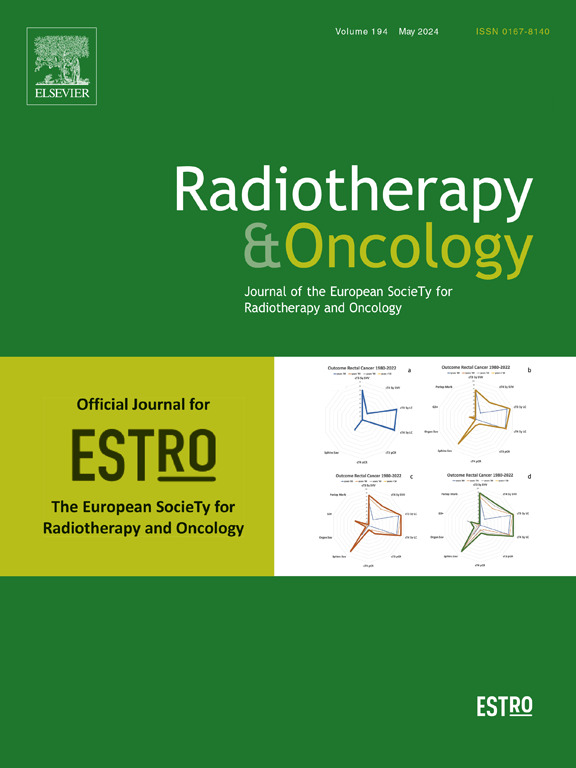小儿弥漫性内生性脑桥胶质瘤和弥漫性中线胶质瘤的再照射治疗
IF 4.9
1区 医学
Q1 ONCOLOGY
引用次数: 0
摘要
背景与目的弥漫性内生性脑桥胶质瘤(DIPG)和弥漫性中线胶质瘤(DMG)是无法治愈的脑恶性肿瘤。在这项研究中,我们报道了一项已知的最大的单机构队列DIPG/DMG患者接受再照射(RT2),以评估其对生存的影响。材料与方法回顾性分析18岁以下儿童DIPG/DMG初始分形光子放射治疗(RT1)和随后复发的病例。对接受或不接受RT2治疗的患者进行比较。主要终点是RT1后复发时间和RT2开始(RT2组)的总生存期(OS)。结果共纳入118例患儿,其中39例接受RT2治疗。接受RT2治疗的儿童具有更好的OS, 6个月OS为66%,而未接受RT2治疗的儿童为22% (p <;0.0001)。RT2组的中位生存期为6.9个月,而仅RT1组为2.7个月。从RT1到RT2的中位时间为7.7个月;RT1和RT2潜伏期大于1年的患者从RT2开始的生存期更长(中位10.9个月vs 5.5个月,p = 0.023)。61%接受RT2治疗的患者在RT2后神经系统症状得到改善。多因素分析发现,年龄较小、rt1重新评估MRI后4周的不良影像学发现(包括假进展)以及RT2缺失是影响OS的不良预后因素。结论放射治疗可改善复发性DIPG和DMG患儿的生存和神经功能恢复。有必要确定新的生物标志物,以更好地选择对RT2反应最佳的患者。本文章由计算机程序翻译,如有差异,请以英文原文为准。
Re-irradiation for children with diffuse intrinsic pontine glioma and diffuse midline glioma
Background and purpose
Diffuse intrinsic pontine glioma (DIPG) and diffuse midline glioma (DMG) are incurable brain malignancies. In this study, we report one of the largest known single-institution cohorts of DIPG/DMG patients undergoing re-irradiation (RT2) to evaluate its effect on survival.
Materials and methods
Children aged less than 18 years treated for DIPG/DMG with initial fractionated photon radiotherapy (RT1) and had subsequent recurrence were retrospectively reviewed. Patients treated with or without RT2 were compared. The primary outcomes were overall survival (OS) from time of recurrence after RT1, and from start of RT2 (for the RT2 group).
Results
A total of 118 children were included, 39 of whom received RT2. Children treated with RT2 had superior OS, with 6-month OS of 66 % vs 22 % in those who did not undergo RT2 (p < 0.0001). Median survivals were 6.9 months for the RT2 group vs 2.7 months for RT1 only. Median time from RT1 to RT2 was 7.7 months; patients with a greater than 1-year latent time between RT1 and RT2 had longer OS from start of RT2 (median 10.9 months vs 5.5 months, p = 0.023). 61 % of those treated with RT2 experienced improvement of neurologic symptoms post-RT2. Multivariate analysis identified younger age, adverse imaging findings on the 4-week post-RT1 reassessment MRI (including pseudoprogression), and the absence of RT2 as poor prognostic factors for OS.
Conclusion
Re-irradiation was associated with improved survival and neurological recovery in children with recurrent DIPG and DMG. There is a need to identify novel biomarkers to better select patients who respond best to RT2.
求助全文
通过发布文献求助,成功后即可免费获取论文全文。
去求助
来源期刊

Radiotherapy and Oncology
医学-核医学
CiteScore
10.30
自引率
10.50%
发文量
2445
审稿时长
45 days
期刊介绍:
Radiotherapy and Oncology publishes papers describing original research as well as review articles. It covers areas of interest relating to radiation oncology. This includes: clinical radiotherapy, combined modality treatment, translational studies, epidemiological outcomes, imaging, dosimetry, and radiation therapy planning, experimental work in radiobiology, chemobiology, hyperthermia and tumour biology, as well as data science in radiation oncology and physics aspects relevant to oncology.Papers on more general aspects of interest to the radiation oncologist including chemotherapy, surgery and immunology are also published.
 求助内容:
求助内容: 应助结果提醒方式:
应助结果提醒方式:


